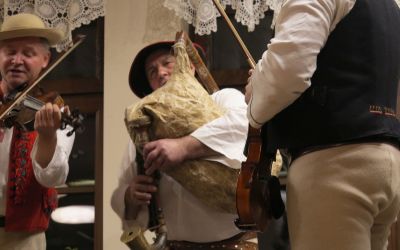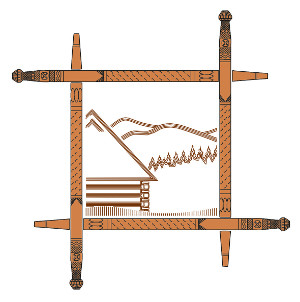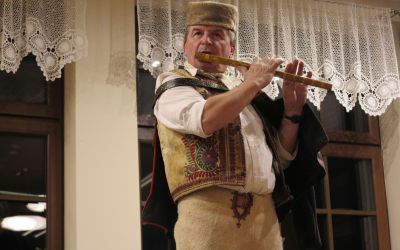
The Festival of Polish Highlanders' Folklore in Żywiec takes place in the Żywiec amphitheater near Grojec. The August event attracts highlanders from all over the country. The event has been organized as part of the Beskid Culture Week since 1970. and is the largest event in Poland. The folk music competition takes place in the categories of bands, singing groups and soloists.
Gorolski Feast - Hello! Ho! Ho! Na Gorola! The largest folklore event in Zaolzie. The three-day program takes place in the City Forest in Jabłonków. The Friday program entitled " Not only from Naszidzichta " focuses on musical and verbal folklore of the Carpathian Arch. The organizers take care of the presentation of authentic and traditional singing forms. On Saturday, there is an overview of children's and youth groups that recreate customs from the area of 1cieszyński Silesia. Sunday procession of allegorical wagons depicting the old life in a cottage and in Sałasz of the Silesian Highlanders. In addition to the feast for the spirit, there is food for the body in the form of Beskid cuisine.
Mishani sheep are the merging of several gazda sheep into one herd. In shepherd rituals a very important day during which magic activities were carried out to protect all of the shasha. Nowadays it is an event attracting not only residents of a given commune, but many tourists. As a curiosity to be a message for J. Coots supposedly at a time when the Silesian Beskid Mountains in shepherding was in full bloom, it was the custom that during the solemn spring wypędu sheep and cattle sałasze gazda donned black leggings in the middle, half white, the left leg it was made of black and right of white cloth. This meant a wealth of gazda, which introduced various black and white sheep to pastures. Sheep incenses and reads . Among the magical treatments that are already taking place in Sasha, mention should be made a triple lap three times; panicles- in Korbielów in Cieszyn Silesia- moiczka , cut herringbone. Sheep were also incensed with herbs. It happened that the shepherds, wanting to separate their sheep, put on their bells while they were mixing . There have never been enough of them for all animals. The characteristic sound of the pickles - bells is obscenity . Sheep coming out of the hall during the autumn reykjaxe informed residents about the pasturing season. Their wearing by the sheep was aimed at faster locating the one who got lost. Then followed the first milking of milk, from which the shareholders were offered cheese. In this gesture, a community of work and responsibility for prosperity and multiplication was created. The date for mowing and breeding sheep was determined in clusters . Special gazda gatherings, who also chose a sashnik among themselves .
Sheep breeding took place in autumn, around September 29 (by Michał). It consisted in disconnecting the herds and returning the grazing team to the farms. Sometimes the hosts grazed out of season in the yard . Today, after the end of the season, shepherds are distributing redykołka on reykki. Usually Bacowski has been taking place since 2007. in the area of Osada Pasterska in Soblówka. The ideas of custom were initiated by Marian Sporek, who promotes traditional shepherd rites, including through a sheep mishan show, shepherd kosor shepherd , milking sheep in stalls, milk begging , cheese making and most of all taste sheep specialties.
Polish Championships in Passing Mutton in Ustroń The propagator of the idea of bringing lamb back to the Beskids tables was Jan Sztefek, known as the Great Highwayman of the Gromada Górala in Cieszyn Silesia. The first Championships were held in 2006 on the Ustroń market. During the event there is a Polish Culinary Cup competition for the best mutton dish. The event is accompanied by discussion panels, exhibitions, shows and performances by regional bands. The main organizers of the championships are Leszek Makulski, Zbójnicka Council of the Highlanders Gromada in Cieszyn Silesia and the Polish Association of Chefs and Confectioners and RM GASTRO in Ustroń. The event is held annually in the first half of August and attracts crowds of tasters.
International meetings of Gajdosz and Piper in Istebna
The opportunity to present traditional instruments of the Carpathian Arch are just meetings ... The organizer of the event is Kapela Wałasi. In this year's edition, which took place in November, bands from the Silesian and Żywiec Beskids as well as multi-instrumentalist from Banská Bystrica in Slovakia - Ľubomír Tatarka presented themselves. The meetings integrate musicians from different sides and additionally anyone interested can hear this unique instrument and former repertoire. In addition to old songs, there are also new arrangements created in the tradition. The instruments included shepherd's instruments.
Carpathian Congress
The reason for restoring cyclical meetings of the People of the Mountains was a look back at the First Festival of the Mountains, which took place in Zakopane in 1935, the following year took over the ideas of Sanok, and in 1937. the organization was undertaken by Wisła. The desire for annual international meetings of the Carpathian arc is being realized anew, because the First Carpathian Congress took place in Humanimierz in 2015, another took place in Sanok, and the third in Istebna. It is a perfect place for dialogue on research and development of folk culture. During the 3rd Congress in Istebna, a rich program was provided for both topic experts and tourists who could participate in the Wallachian Assembly at Hala Baraniej and integration meetings.















